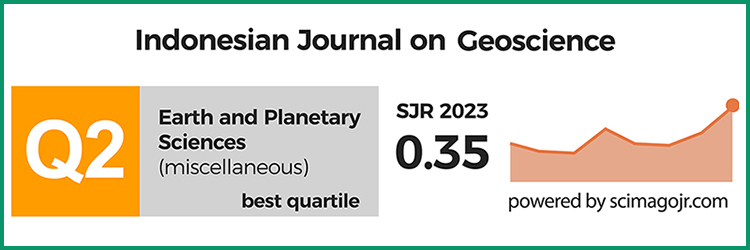Metamorphic Evolution of Garnet-bearing Epidote-Barroisite Schist from the Meratus Complex in South Kalimantan, Indonesia
DOI:
https://doi.org/10.17014/ijog.2.3.139-156Keywords:
garnet-bearing epidote-barroisite schist, pressure-temperature path, high-pressure metamorphic rocks, Meratus Complex, South KalimantanAbstract
DOI:10.17014/ijog.2.3.139-156
This paper presents metamorphic evolution of metamorphic rocks from the Meratus Complex in South Kalimantan, Indonesia. Eight varieties of metamorphic rocks samples from this location, which are garnet-bearing epidote-barroisite schist, epidote-barroisite schist, glaucophane-quartz schist, garnet-muscovite schist, actinolite-talc schist, epidote schist, muscovite schist, and serpentinite, were investigated in detail its petrological and mineralogical characteristics by using polarization microscope and electron probe micro analyzer (EPMA). Furthermore, the pressure-temperature path of garnet-bearing epidote-barroisite schist was estimated by using mineral parageneses, reaction textures, and mineral chemistries to assess the metamorphic history. The primary stage of this rock might be represented by the assemblage of glaucophane + epidote + titanite ± paragonite. The assemblage yields 1.7 - 1.0 GPa in assumed temperature of 300 - 550 °C, which is interpreted as maximum pressure limit of prograde stage. The peak P-T condition estimated on the basis of the equilibrium of garnet rim, barroisite, phengite, epidote, and quartz, yields 547 - 690 °C and 1.1 - 1.5 GPa on the albite epidote amphibolite-facies that correspond to the depth of 38 - 50 km. The retrograde stage was presented by changing mineral compositions of amphiboles from the Si-rich barroisite to the actinolite, which lies near 0.5 GPa at 350 °C. It could be concluded that metamorphic rocks from the Meratus Complex experienced low-temperature and high-pressure conditions (blueschist-facies) prior to the peak metamorphism of the epidote amphibolite-facies. The subduction environments in Meratus Complex during Cretaceous should be responsible for this metamorphic condition.
References
Asikin, S., Handoyo, A., Busono, A., and Gafoer,S., 2007. Geological map of the Kebumen Quadrangles, Jawa; Scale 1:100,000. Geological Research and Development Centre of Indonesia. Bandung.
Berman, R.G., 1990. Mixing properties of Ca-Mg-Fe-Mn garnets. American Mineralogist, 75, p.328-344.
Droop, G.T.R., 1987. A general equation for estimating Fe3+ concentrations in ferromagnesian silicates and oxides from microprobe analyses, using stoichiometric criteria. Mineralogical Magazine, 51, p.431-435.
Enami, M., Ko, Z.W., Win, A., and Tsuboi., 2011. Eclogite from the Kumon range, Myanmar: Petrology and tectonic implications. Gondwana Research, 21, p.548-558.
Evans, B.W., 1990. Phase relations of epidoteblueshists. Lithos, 25, p.3-23.
Green, T.H. and Hellman, P.L., 1982. Fe-Mg partitioning between coexisting garnet and phengite at high pressure, and comments on a garnet-phengite geothermometer. Lithos, 15, p.253-266.
Heinrich, H. and Althaus, E., 1988. Experimental determination of the 4 lawsonite + 1 albite = 1 paragonite + 2 zoisite + 2 quartz + 6 H2O and 4 lawsonite + 1 jadeite = 1 paragonite + 2 zoisite + 2 quartz + 6H2O. Neues Jahrbuch Mineral Monatsh, 11, p.516-528.
Kadarusman, A. and Parkinson, C.D., 2000. Petrology and P-T evolution of garnet peridotites from central Sulawesi, Indonesia. Journal of Metamorphic Geology, 18, p.193-209.
Kadarusman, A., Miyashita, S., Maruyama, S., Parkinson, C.D., and Ishikawa, A., 2004. Petrology, geochemistry and paleogeographic reconstruction of the East Sulawesi Ophiolite, Indonesia. Tectonophysics, 392, p.55-83.
Kadarusman, A., Massonne, H.J., Roermund, V.H., Permana, H., and Munasri., 2007. P-T evolution of eclogites and blueschists from the Luk Ulo Complex of Central Java, Indonesia. International Geology Review, 49, p.329-356.
Krogh, E.J. and Raheim, A., 1978. Temperature and pressure dependence of Fe-Mg partitioning between garnet and phengite, with particular reference to eclogite. Contributions to Mineralogy and Petrology, 66, p.75-80.
Leake, B.E., Woolley, A.R., Arps, C.E.S., Birch, W.D., Gilbert, M.C., Grice, J.D., Hawthorne, F.C., Kato, A., Kisch, H.J., Krivovichev, V. G., Linthout, K., Laird, J., Mandarino, J.A., Maresch, W.V., Nickel, E.H., Rock, N.M.S., Schumacher, J.C., Smith, D.C., Stephenson, N.C.N., Ungaretti, L., Whittaker, E.J.W., and Youzhi, G., 1997. Nomenclature of amphiboles: report of the subcommittee on amphiboles of the International Mineralogical Association, Commission on New Minerals and Mineral Names. The Canadian Mineralogist, 35, p.219-246.
van Leeuwen, T., Allen, C.M., Kadarusman, A., Elburg, M., Palin, J.M., Muhardjo, and Suwijanto., 2006. Petrologic, isotopic, and radiometric age constraints on the origin and tectonic history of the Malino Metamorphic Complex, NW Sulawesi, Indonesia. Journal of Asian Earth Sciences, 29, p.751-777.
Manning, C.E. and Bohlen, S.R., 1991. The reaction titanite + kyanite = anorthite + rutile and titanite-rutile barometry in eclogites. Contributions to Mineralogy and Petrology, 109, p.1-9.
Marresch, W.V., 1977. Experimental studies on glaucophane: an analysis of present knowledge. Tectonophysics, 43, p.109-125.
Maruyama, S., Liou, J.G., and Terabayashi, 1996. Blueschist and eclogites of the world and their exhumation. International Geology Review, 38, p.485-594.
Massone, H.J. and Schreyer, W., 1987. Phengite geobarometry based on the limiting assemblage with K-feldspar, phlogopite, and quartz. Contributions to Mineralogy and Petrology, 96, p.212-214.
Miyazaki, K., Zulkarnain, I., Sopaheluwakan, J. and Wakita, K., 1996. Pressure-temperature conditions and retrograde paths of eclogites, garnet-glaucophane rocks and schists from South Sulawesi, Indonesia. Journal of Metamorphic Geology, 14, p.549-563.
Miyazaki, K., Sopaheluwakan, J., Zulkarnain, I., and Wakita, K., 1998. Jadeite-quartz- glaucophane rock from Karangsambung, Central java, Indonesia and its tectonic implications. The Island Arc, 7, p.223-230.
Otsuki, M. and Banno, S., 1990. Prograde and retrograde metamorphism of hematitebearing basic schists in the Sanbagawa belt in central Shikoku. Journal of Metamorphic Geology, 8, p.425-439.
Parkinson, C.D., 1998. An outline of the petrology, structure, and age of the Pompangeo schist Complex of central Sulawesi, Indonesia. The Island Arc, 7, p.231-245.
Parkinson, C.D., Miyazaki, K., Wakita, K., Barber, A.J., and Carswell, A., 1998. An overview and tectonic synthesis of the pre-Tertiary very-high-pressure metamorphic and associated rocks of Java, Sulawesi and Kalimantan, Indonesia. The Island Arc, 7, p.184-200.
Setiawan, N.I., 2013. Metamorphic evolution of central Indonesia. PhD Thesis (unpublished), Kyushu University, Japan. 318pp.
Sikumbang, N. and Heryanto, R., 2009. Geological map of the Banjarmasin Quadrangle, Kalimantan. Scale 1:250,000. Geological Research and Development Centre of Indonesia. Bandung.
Sukamto, R., 1982. Geological map of Pangkajene and western part of Watampone Quadrangles, Sulawesi. Scale 1:250,000. Geological Research and Development Centre of Indonesia. Bandung.
Wakita, K., Munasri., Sopaheluwakan, J., Zulkarnain, I., and Miyazaki, K., 1994a. Early Cretaceous tectonic events implied in the time-lag between the age of radiolarian chert and its metamorphic basement in the Bantimala area, South Sulawesi, Indonesia. The Island Arc, 3, p.90-102.
Wakita, K., Munasri. and Bambang, W., 1994b. Cretaceous radiolarians from the Luk Ulo Complex in the Karangsambung area, central Java, Indonesia. Journal of SE Asian Earth Sciences, 9, p.29-43.
Wakita, K., Sopaheluwakan, J., Miyazaki, K., Zulkarnain, I., and Munasri., 1996. Tectonic evolution of the Bantimala Complex, South Sulawesi, Indonesia, In: Hall, R., Blundell, D.J. (Eds.), Tectonic Evolution of Southeast Asia. Geological Society of London Special Publication, 106, p.353-364.
Wakita, K., Miyazaki, K., Zulkarnain, I., Sopaheluwakan, J., and Sanyoto, P., 1998. Tectonic implications of new age data for the Meratus Complex of south Kalimantan, Indonesia. The Island Arc, 7, p.202-222.
Whitney, D.L. and Evans, B.W., 2010. Abbreviations for names of rock-forming minerals. American Mineralogist, 95, p.185-187.
Williams, P.R., Johnston, C.R., Almond, R.A., and Simamora, W.H., 1988. Late Cretaceous to Early Tertiary structural elements of West Kalimantan. Tectonophysics, 178, p.279-297.
Wilson, M.E.J. and Moss, S.J., 1999. Cenozoic palaeogeographic evolution of Sulawesi and Borneo. Palaeogegraphy, Palaeoclimotology, Palaeoecology, 145, p.303-337.
Yuwono, Y.S., Priyomarsono, S., Maury, R.C., Rampnoux, J.P., Soeria-Atmadja, R., Bellon, H., and Chotin, P., 1988. Petrology of the Cretaceous magmatic rocks from Meratus Range, southeast Kalimantan. Journal of Southeast Asian Earth Sciences, 2, p.15-22.
Zulkarnain, I., 2003. Quartz-Chloritoid rock from Bobaris Range South Kalimantan, Indonesia. RISET - Geologi dan Pertambangan, 13, p.27-38.



















